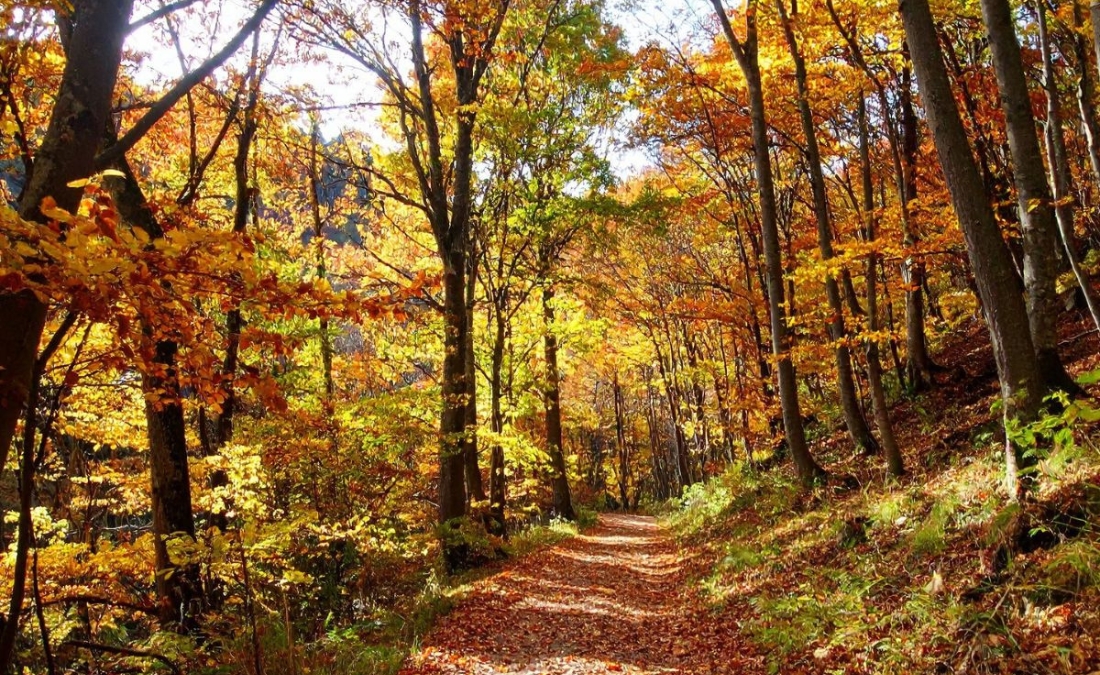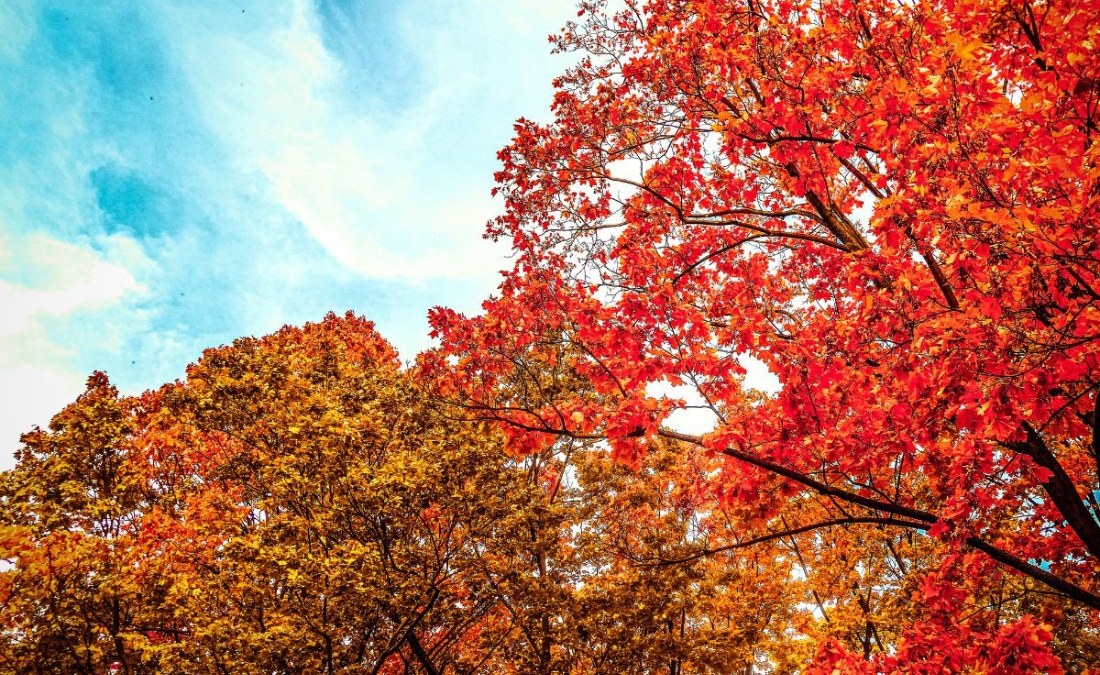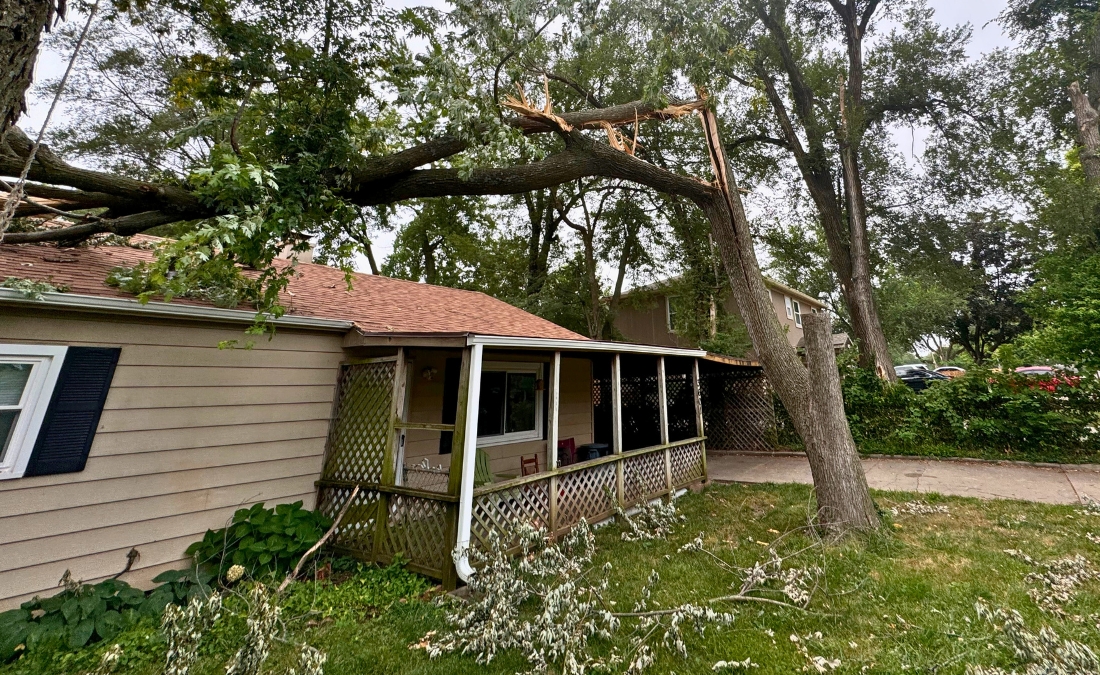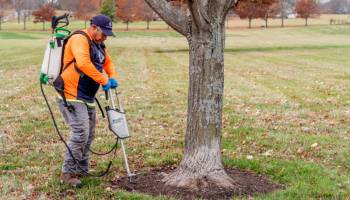Preventing Wind Damage to Wichita Trees: The Science Behind Proper Pruning
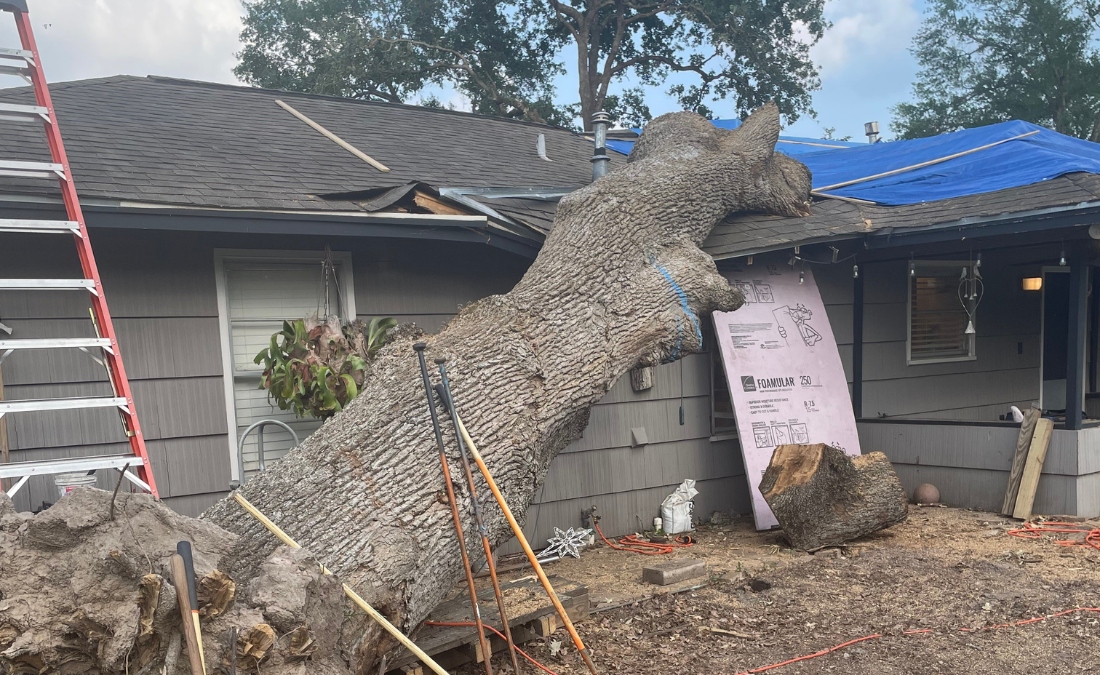
Don’t let the next storm tear through your yard. Learn how expert pruning from Wichita’s ISA Certified Arborists is key to preventing wind damage to your trees.
When 101 mph winds tore through Wichita in June 2025, trees throughout College Hill, Vickridge, and The Trees neighborhoods told two very different stories. Some mature trees remained standing with minor branch loss, while others suffered catastrophic failure or severe crown damage. The difference often came down to one critical factor: how those trees had been pruned and maintained over the years.
If you’re a homeowner in any of Wichita’s established neighborhoods with mature trees, you’ve probably heard the common advice to “thin out your trees so the wind can blow through them.” This widespread misconception has led to countless improperly pruned trees that are actually more vulnerable to wind damage, not less.
Key Takeaways
- Proper structural pruning targets weak branch attachments and co-dominant stems, not crown density.
- Excessive crown thinning can increase wind load by removing the tree’s natural dampening system.
- Young tree training prevents structural problems that cause wind failure in mature trees.
- Native Kansas species, like bur oak and hackberry, naturally resist wind when properly maintained.
- Regular inspections by ISA Certified Arborists identify wind-related risks before storms strike.
How Do Trees Resist Wind Damage?
Trees have evolved sophisticated mechanisms to handle wind forces that most homeowners never see in action. When wind hits a healthy tree, the crown doesn’t just bend – it creates a complex system of energy dissipation that protects the trunk and root system from catastrophic failure. Research from the University of Florida’s Institute of Food and Agricultural Sciences shows that foliage, twigs, and flexible branch tips dampen wind oscillations and dissipate more wind energy than the trunk itself.
This natural engineering explains why trees with full, healthy crowns often weather severe storms better than those that have been heavily thinned. The small, flexible parts of the tree work together like shock absorbers, reducing the total wind load that reaches the trunk and root system.
“The key to wind resistance isn’t removing branches – it’s ensuring the tree has proper structure to flex without breaking. When we remove too much of the crown, we’re actually dismantling the tree’s natural defense system.” – Seth Blank, Arbor Advisor Arbor Masters
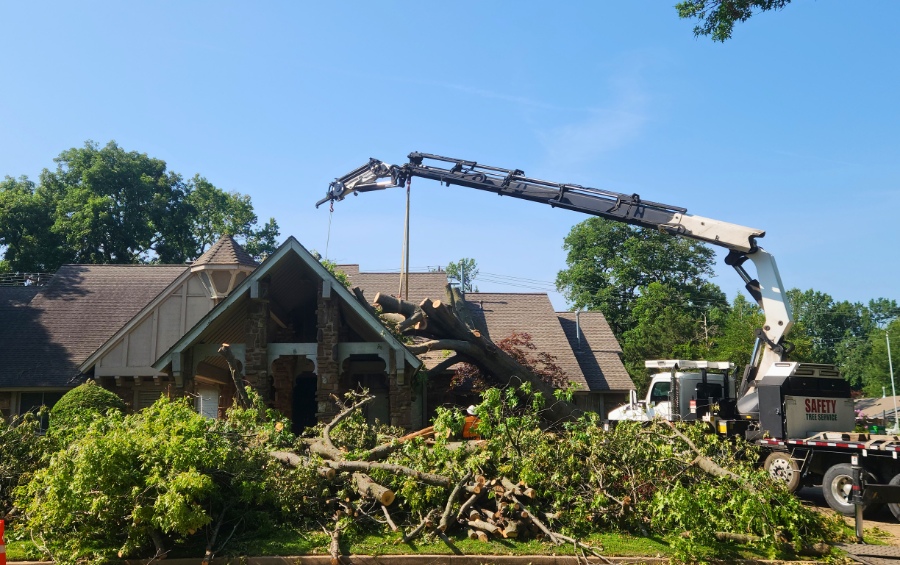
The aftermath of inadequate tree maintenance: Professional cleanup required after trees fail during severe weather events.
Does Thinning a Tree’s Crown Make It More Wind Resistant?
The idea that heavily thinning a tree’s crown will make it “wind resistant” by allowing air to pass through has been thoroughly debunked by forest research, yet it persists among some tree service providers.
This practice, sometimes called “wind sailing” or “hurricane pruning,” can actually increase the risk of tree failure. The Washington Department of Natural Resources published research showing that aggressive crown thinning makes remaining branches more vulnerable to failure by leaving them isolated and unable to share wind loads.
A landmark study published in Arboriculture & Urban Forestry examined how different pruning techniques affect tree movement in hurricane-force winds. Researchers found that while crown reduction and proper thinning reduced upper trunk movement, simply raising the crown (removing lower branches) provided no protection against wind damage.
More importantly, the study confirmed that foliage positioned at the top of trees creates a greater force on the trunk than the same amount of foliage on lower branches. This means the common practice of “limbing up” young trees (removing lower branches while leaving a heavy crown) can actually increase wind vulnerability.
In Wichita’s established neighborhoods, you can often see the results of improper “wind sailing” pruning from years past. Trees that were severely thinned show characteristic signs: sparse crowns with long, weak branches, multiple small branches growing from old pruning cuts, and increased susceptibility to storm damage.
PRO TIP: The science is clear: trees need their natural crown structure to effectively manage wind forces. Proper pruning works with these natural systems, not against them.
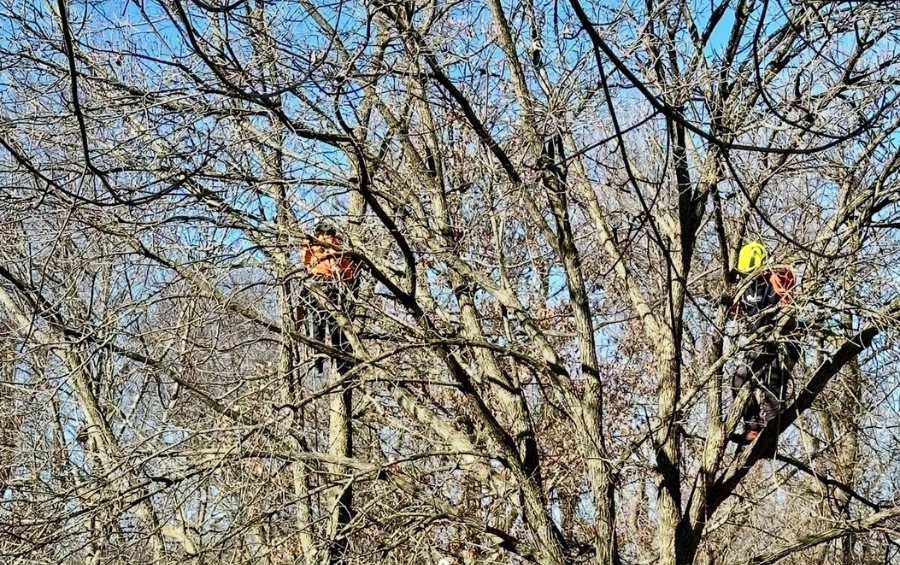
Proper timing matters: Our Certified Arborists perform structural pruning during late winter dormancy to maximize tree health and wind resistance.
What Type of Pruning Actually Prevents Wind Damage?
Effective wind damage prevention focuses on structural problems that create weak points in the tree, not on reducing crown density. This approach requires understanding tree biology and following established standards like ANSI A300, which our ISA Certified Arborists use for every pruning project.
“When we prune trees, we’re not just shaping the inside and outside of the tree – we’re working with how the whole tree moves in the wind. Interior branches actually help absorb wind energy, so we avoid the harmful practice of ‘lion-tailing’ that strips them out. We focus on reducing overextended limbs that carry too much weight at the tips, since those are the ones most likely to fail in a storm. Every cut is made with a clear purpose: to keep your tree balanced, resilient, and less likely to suffer storm damage.” – Stephen Carlson, Director of Sales at Arbor Masters
What Hazards Should Be Removed to Prevent Wind Failure?
The main hazards that should be removed to prevent wind failure are weak branch attachments, damaged wood, and competing stems that compromise a tree’s structure. These issues increase stress points where trees are most likely to split or break during storms. When our arborists inspect for wind resilience, they focus on correcting the following:
- Co-Dominant Stems: Two or more trunks of similar size competing for dominance. These unions are inherently weak because they lack the strong wood structure of a single trunk with subordinate branches. When wind forces hit co-dominant stems, they create a splitting action that can tear the tree apart.
- Narrow Attachment Angles: Branches with angles less than 30 degrees often develop included bark, where bark grows between the branch and trunk instead of strong connecting wood. During wind events, these connections act like stress concentrators, often failing when loads increase.
- Crossing or Rubbing Branches: These create wounds and weak points that compromise the tree’s structural integrity during wind events.
- Dead or Damaged Wood: Removes potential failure points before they become hazardous during storms.
How Should Common Wichita Tree Species Be Pruned for Wind Resistance?
Common Wichita tree species should be pruned for wind resistance by focusing on structure, balance, and long-term strength rather than short-term appearance. Each species responds differently to pruning, so our arborists tailor their approach to reinforce natural growth patterns and reduce failure risks in Kansas winds:
- Hackberry Trees: Benefit from early removal of competing stems and weak branches. Their naturally brittle wood makes proper structure essential for long-term survival in Kansas winds.
- Eastern Cottonwoods: Require careful management of their rapid growth. Structural pruning should establish good branch spacing while the tree is young, preventing overcrowded conditions that lead to breakage.
- Oak Species: Respond well to gradual crown development over several years. Rather than making large cuts that stress the tree, our arborists use a systematic approach that maintains the tree’s natural energy balance.
The timing of structural pruning matters significantly in Wichita’s climate. Late winter, during dormancy, provides the best window for major structural work. This timing allows cuts to heal properly before the stress of spring growth and summer heat.
PRO TIP: Learn more about optimal pruning timing for different seasons to maximize your trees’ health and wind resistance.
Can I Train Young Trees to Resist Wind Damage?
Yes, you can train young trees to resist wind damage by developing a strong central leader, selecting well-spaced scaffold branches, and correcting weak structures early. The first 10–15 years of growth are critical for shaping stable architecture that can withstand Kansas winds for decades. Proper structural pruning during this period builds strength, balance, and flexibility that mature trees can’t easily regain later.
Central leader training forms the foundation of wind-resistant tree structure. This technique maintains one dominant trunk with subordinate lateral branches, creating the strongest possible architecture for handling wind loads. Trees with multiple leaders or co-dominant stems will always be more vulnerable to wind damage.
Scaffold branch selection requires careful planning and gradual implementation. The ideal arrangement includes major branches that are vertically spaced at least 18-24 inches apart and radially distributed around the trunk. This spacing prevents overcrowding and reduces the risk of branches interfering with each other during wind events.
Young tree training should focus on:
- Establishing one central leader and removing competing stems early in the tree’s development
- Selecting well-spaced scaffold branches that will become the tree’s permanent framework
- Gradually removing temporary branches as the tree matures, maintaining proper taper development
- Correcting narrow crotch angles and weak attachments while they’re still small and easy to manage
When Do Trees Need Cabling or Bracing for Wind Protection?
Trees need cabling or bracing when they have structural vulnerabilities that cannot be corrected through pruning alone, such as co-dominant stems in mature trees, large horizontal branches over structures, or previous storm damage. Cabling and bracing systems can provide crucial reinforcement for trees with structural vulnerabilities that can’t be addressed through pruning alone.
These support systems are particularly valuable for:
- Mature trees with co-dominant stems that developed before proper training
- Trees with large horizontal branches that extend over structures
- Historically significant trees that are worth preserving despite structural challenges
- Trees recovering from previous storm damage
Our Certified Arborists use ANSI A300 standards for tree support systems, ensuring that cables and braces provide effective reinforcement without harming the tree’s natural growth patterns.
PRO TIP: Have more questions about tree safety and care? Check out our comprehensive guide to common tree safety questions for additional expert insights.
Frequently Asked Questions
How much of my tree’s canopy can be safely removed?
Never remove more than 25% of a tree’s live canopy in a single year, and typically much less. Focus on specific structural problems rather than overall crown reduction. Healthy trees rarely need significant canopy removal for wind resistance.
How often should trees be inspected for wind damage risk?
Annual inspections by an ISA Certified Arborist can identify developing problems before they become serious. After severe weather events, immediate inspection helps assess any new damage or structural changes.
What should I do immediately after a windstorm?
Stay away from damaged trees until they can be professionally assessed. Document damage with photos for insurance purposes, but don’t attempt to remove hanging branches yourself. Contact a Certified Arborist for proper evaluation and safe cleanup. Be aware of hidden risks in storm-damaged trees that aren’t immediately obvious from the ground.
What are some wind-resistant tree species to plant in Wichita?
Some species we recommend planting include:
- Bur oak
- Eastern red cedar
- Hackberry
Avoid planting Bradford pear trees. These trees are notoriously brittle, and Kansas is enacting a quarantine of them starting in 2027.
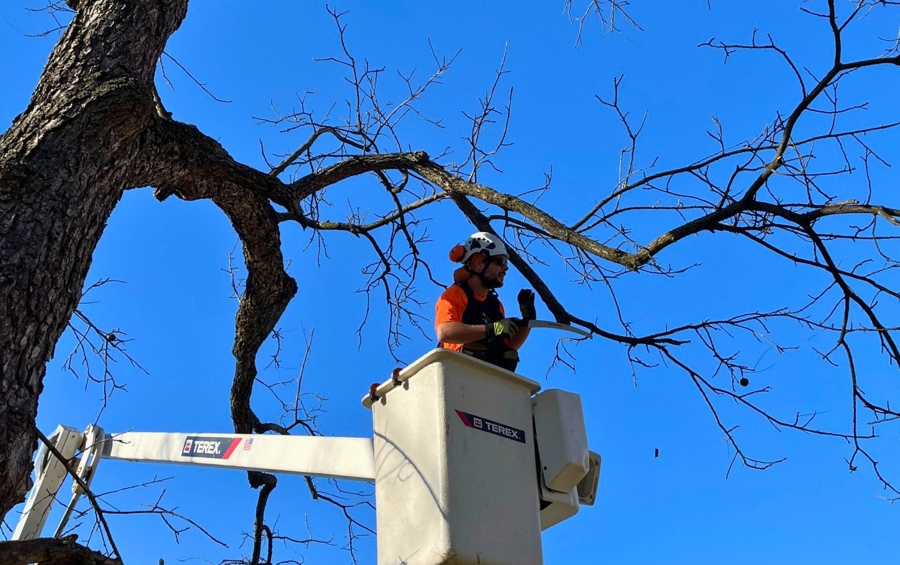
Our ISA Certified Arborists use professional equipment and follow ANSI A300 standards for every pruning cut to ensure proper healing and tree health.
Don’t Let Wind Destroy Your Trees; Get Professional Pruning from Arbor Masters Today
After Wichita’s 101 mph winds and recurring severe weather, proper tree care is more important than ever. At Arbor Masters, our ISA Certified Arborists understand the science behind wind resistance and follow proven standards for every pruning project.
As a TCIA Accredited company with over 60 years of Kansas experience, we provide professional tree pruning in Wichita, emergency response, and preventive tree health care that builds natural wind resistance.
Don’t wait for the next storm to discover your trees’ vulnerabilities. Call us today at 316-838-3111 or request a quote online for tree pruning today.

Get the latest local news, tree care tips, special offers, and company updates directly to your inbox! It's easy to subscribe and there's no spam - we promise.
"*" indicates required fields


